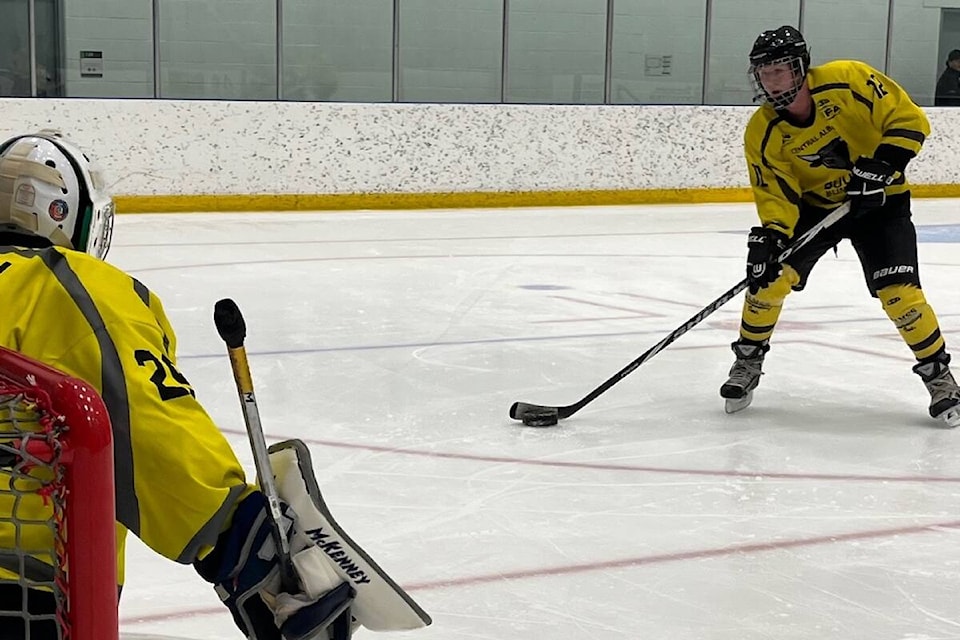Fans of Central Alberta Bullseye Blind Hockey won’t want to miss out on a Nov. 4 match-up at Red Deer’s Gary W. Harris Canada Games Centre.
Game time is slated for 10 a.m. and Lacombe-area resident Dustin Butterfield, who heads up the Bullseye team, can’t wait to hit the ice and then take in some of the Canadian Finals Rodeo action that will be running in Red Deer at the same time.
“I’m trying to get as many of the Alberta blind hockey players as possible to come out and play for that game,” said Butterfield, adding that the Bullseye team is now into its fifth season.
“Usually, each year we try to have one game day where we get all (our) people together. It’s usually in March, a couple of weeks before the Canadian National Tournament in Toronto,” he said.
“But this year, with the Canadian Finals Rodeo being on at the same time in (Red Deer), my wife suggested that we have a game during that.
“I reached out to the Canadian Pro Rodeo Association just to see if they wanted to be involved, or even just to let them know what my plans were. They thought it was a cool idea.
“I got a big group of the Hall of Fame cowboys and cowgirls who are going to watch part of the game, and then near the end, we are going to get them to come to the edge of the ice and get a photo of them with the players.”
Rodeo action begins as the game wraps up, so Butterfield is hoping it all works together to bring more spectators to the game.
“Red Deer Polytechnic, which operates the rink there, has treated us like gold these (past) five years,” he said. “It’s an excellent facility and their staff has been very helpful.”
Butterfield, who has a genetic eye disease that has left him partially sighted with some peripheral vision, played minor hockey from about the age of five or six until he was 11.
Raised in Stettler County, he launched into rodeo for a time during his youth, but hockey was never off the radar.
In 2017, he made a key connection — he attended a dinner for Fighting Blindness Canada in Edmonton and met a couple of guys who played on a blind hockey team there.
Later that fall, he took part in a Leduc blind hockey tournament. Two games into that, he was absolutely hooked, he said.
These days, the Central Alberta Bullseye team has about seven or eight visually impaired adult players and one or two youth.
For Butterfield, it’s been an absolute joy to be a part of, and he’s consistently heading off to compete in any number of competitions and tournaments.
Last year at the time, he was off to Indiana, and this past March he was in Toronto for another Team Canada/Team U.S.A. series.
There was also a Team Canada summer camp this past August that Butterfield and fellow Bullseye player Blake Schneider took part in in Mississauga, ON.
“They called it the High-Performance Canadian Blind Hockey Camp,” he said.
“We skated every afternoon and evening, and then we had some additional meetings, and special guests talking about mental strength, training, etc. The one feeling I had was that there is a lot of young talent coming up.
“The veteran players are there, but the teams are going to be in good hands.
“Going to those camps, there is also a lot of camaraderie; it’s a lot of fun to be playing the sport. And going to the high-performance camp challenges you. Everybody there is a very good skater — it’s highly skilled.
“There are high expectations, which I enjoy. The more challenges, the more you feel like you need to be fit, and you need to hustle. It’s fun to be there and try to push yourself.”
According to Canadian Blind Hockey, “The sport uses some modified rules and equipment, most notably the adapted puck that makes noise and is larger than a traditional puck. At the recreational level, all athletes must be visually impaired, while at the competitive level, all players must be classified as legally blind, which is defined as having approximately ten percent vision or less.”
Another difference from regular hockey is that the nets are slightly lower, too.
“It has all of the same rules, with just a few adaptations.”
A few years ago, Butterfield also took part in a video called Our Community, Blind Hockey which is on YouTube.
It explores what the team ‘Central Alberta Bullseye Blind Hockey’ – which Butterfield created and facilitates – is all about.
As to the sport in general, Butterfield wants more folks to consider giving it a try.
“If we could get people of any age to just come out and try it. It might feel like an obstacle to go out there, and if they went out on the ice once or twice, they might decide they don’t want to play.
“But they may also find it’s way more fun than they had thought, and that they are doing way better at it than they thought they might do.”
